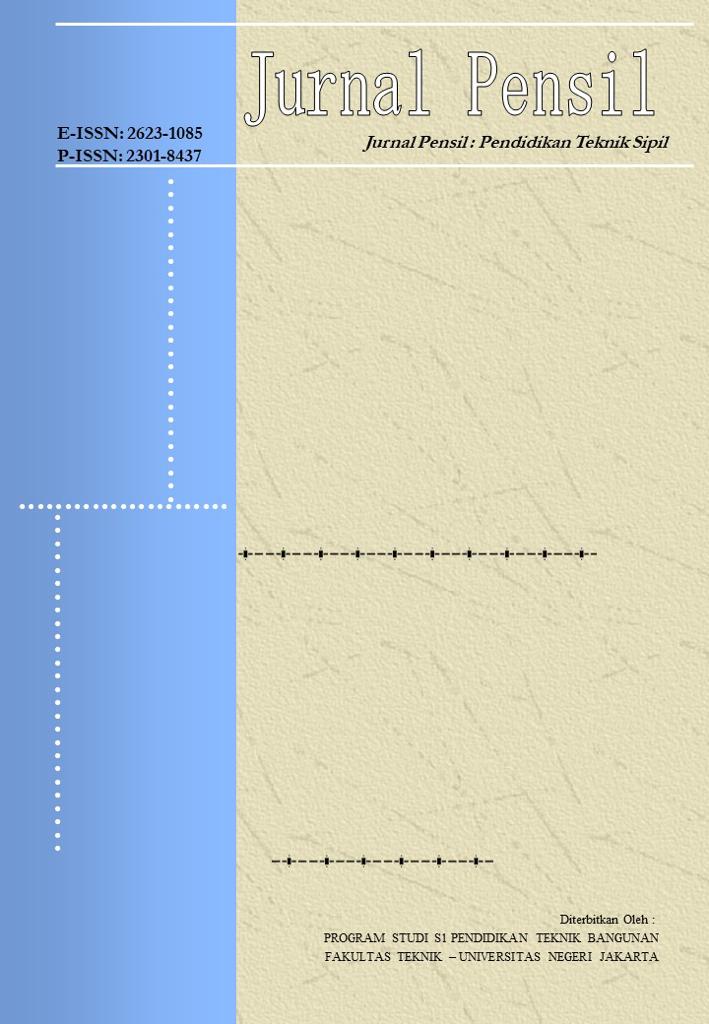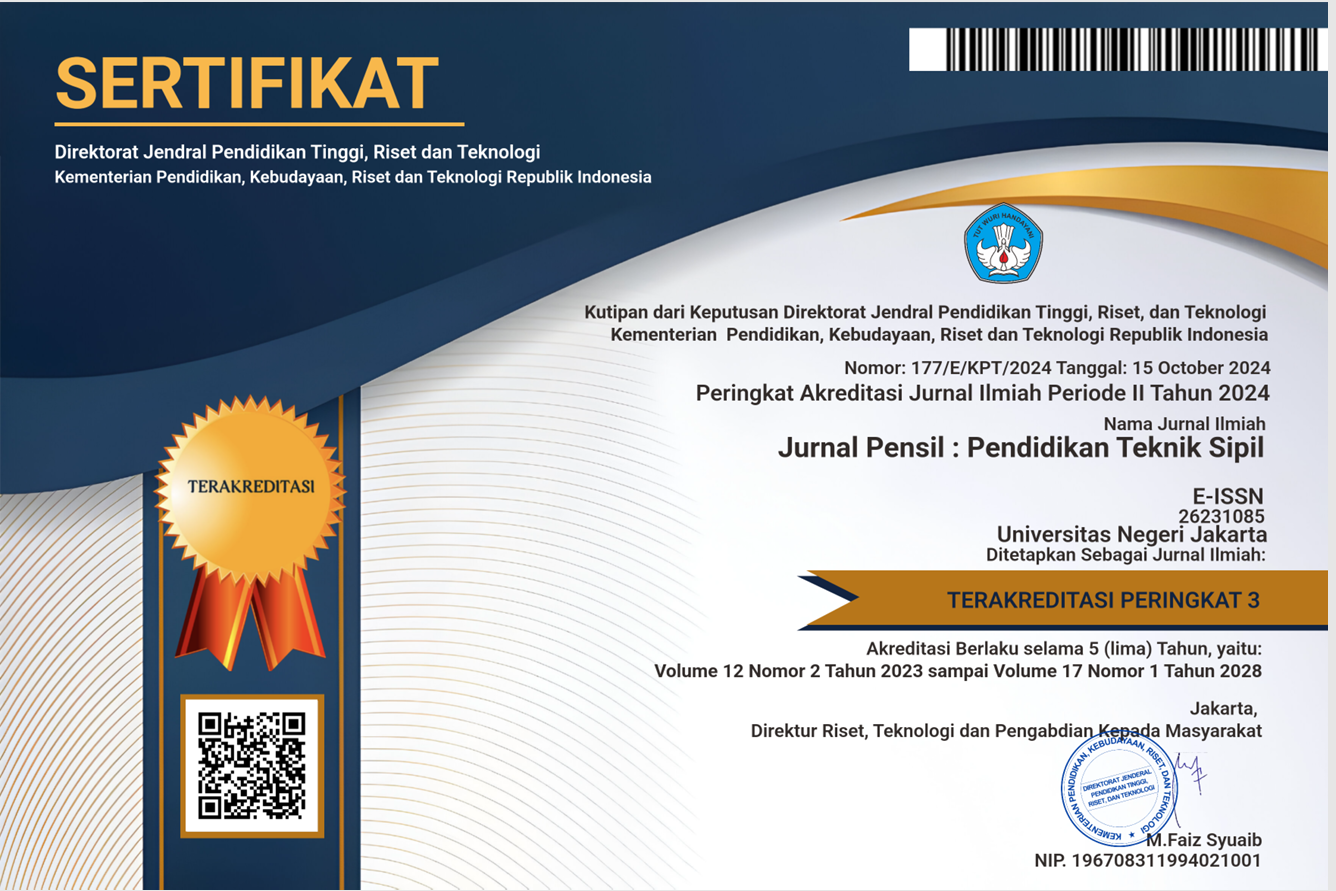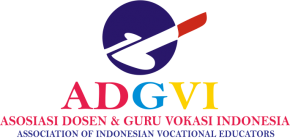DEVELOPMENT OF EFFICIENT AND ENVIRONMENTALLY FRIENDLY SEPTIC TANKS
DOI:
https://doi.org/10.21009/jpensil.v13i3.44130Keywords:
Septic Tank, Efficient, Environmentally Friendly, Constructivist Qualitative MethodAbstract
In many communities in Indonesia, there are still many areas where their homes do not have a toilet (water closet) that meets hygiene and health requirements. This is caused by many factors, including because there are still many people who live below the poverty line, both economically poor and poor in knowledge (human resources). Procurement of toilets (water closets) which also include a septic tank system with a minimum output that is environmentally friendly and of course cost efficient is very necessary to improve public health. Based on the description above, this research was created in order to provide procurement and development of efficient and environmentally friendly septic tanks. This research is very necessary because of the discovery of an efficient alternative material by using used drums which can be used as septic tanks in Lampung, but it has not deepened the issue of waste output that is safe for the environment. This research was carried out using a constructivist qualitative method with assistance from DIGILIB Digital Library & OPAC UB sources. is at Brawijaya University Malang, where the author is registered as a student in the environmental science doctoral program at Brawijaya University Malang.
References
Adegoke, A. A., & Stenstrom, T.-A. (2019). Septic Systems. Water and Sanitation for the 21st Century: Health and Microbiological Aspects of Excreta and Wastewater Management (Global Water Pathogen Project), January 2019. https://doi.org/10.14321/waterpathogens.59
Al-Maliki, S., Al-Taey, D. K. A., & Al-Mammori, H. Z. (2021). Earthworms and eco-consequences: Considerations to soil biological indicators and plant function: A review. Acta Ecologica Sinica, 41(6), 512–523. https://doi.org/10.1016/j.chnaes.2021.02.003
Arora, S., Rajpal, A., Bhargava, R., Pruthi, V., Bhatia, A., & Kazmi, A. A. (2014). Antibacterial and enzymatic activity of microbial community during wastewater treatment by pilot scale vermifiltration system. Bioresource Technology, 166, 132–141. https://doi.org/10.1016/j.biortech.2014.05.041
Arora, S., & Saraswat, S. (2021). Vermifiltration as a natural, sustainable and green technology for environmental remediation: A new paradigm for wastewater treatment process. Current Research in Green and Sustainable Chemistry, 4(January), 100061. https://doi.org/10.1016/j.crgsc.2021.100061
Banerjee, S., Madhogaria, B., Saha, O., kundu, A., & Dhak, P. (2024). Vermifiltration: an opportunity to improve wastewater treatment—a sustainable and natural approach. Discover Water, 4(1). https://doi.org/10.1007/s43832-024-00101-0
Beal, C., Gardner, E., & Menzies, N. (2005). Process, performance, and pollution potential: A review of septic tank-soil absorption systems. Australian Journal of Soil Research, 43. https://doi.org/10.1071/SR05018
Canter, L. W., & Knox, R. C. (2017). Septic Tank System Effects on Ground Water Quality (1st Editio). Lewis Publishers Inc. https://doi.org/https://doi.org/10.1201/9780203739877
Fadli, A., & Alexander, H. B. (2022). Septic Tank Konvensional Paling Banyak Digunakan. Kompas.Com. https://www.kompas.com/properti/read/2022/02/08/080000321/septic-tank-konvensional-paling-banyak-digunakan
Furlong, C., Templeton, M. R., & Gibson, W. T. (2014). Processing of Human Faeces by Wet Vermifiltration for Improved On-Site Sanitation. Journal of Water Sanitation and Hygiene for Development, 4(2), 231–239. https://doi.org/10.2166/washdev.2014.107
He, C., Liu, Z., Wu, J., Pan, X., Fang, Z., Li, J., & Bryan, B. A. (2021). Future global urban water scarcity and potential solutions. Nature Communications, 12(1), 1–11. https://doi.org/10.1038/s41467-021-25026-3
He, Q., & Silliman, B. R. (2019). Climate Change, Human Impacts, and Coastal Ecosystems in the Anthropocene. Current Biology, 29(19), R1021–R1035. https://doi.org/10.1016/j.cub.2019.08.042
Hersaft, A. (1976). The Plight and Promise of On-Site Wastewater Treatment. Compost Science, 17(5), 6–13.
Huang, S., Huang, Y., Chang, W., Chang, L., & ... (2013). Exploring the effects of teacher job satisfaction on teaching effectiveness. In International Journal of …. academia.edu. https://www.academia.edu/download/47777230/IJMEF021_2_1_17_30.pdf
Islam, M., Wattoo, O. M., & Saleem, S. (2023). Environmental Regulations and their Implications for Global Sustainability. Pakistan Journal of Humanities and Social Sciences, 11(3), 3801–3809. https://doi.org/10.52131/pjhss.2023.1103.0665
Ji, Z., Tang, W., & Pei, Y. (2022). Constructed wetland substrates: A review on development, function mechanisms, and application in contaminants removal. Chemosphere, 286, 131564. https://doi.org/https://doi.org/10.1016/j.chemosphere.2021.131564
Kihila, J. M., & Balengayabo, J. G. (2020). Adaptable improved onsite wastewater treatment systems for urban settlements in developing countries. Cogent Environmental Science, 6(1), 1823633. https://doi.org/10.1080/23311843.2020.1823633
Liu, J., Lu, Z., Zhang, J., Xing, M., & Yang, J. (2013). Phylogenetic characterization of microbial communities in a full-scale vermifilter treating rural domestic sewage. Ecological Engineering, 61, 100–109. https://doi.org/10.1016/j.ecoleng.2013.09.015
Malhi, Y., Franklin, J., Seddon, N., Solan, M., Turner, M. G., Field, C. B., & Knowlton, N. (2020). Climate change and ecosystems: Threats, opportunities and solutions. Philosophical Transactions of the Royal Society B: Biological Sciences, 375(1794). https://doi.org/10.1098/rstb.2019.0104
Masykur. (2015). Pemanfaatan Drum Plastik Bekas Sebagai Bahan Pembuatan Septic tank. TAPAK, 5(1), 55–60. http://ojs.ummetro.ac.id/index.php/tapak/article/view/150%0Ahttps://ojs.ummetro.ac.id/index.php/tapak/article/download/150/125
McCulloch, B. (2023). Explainer: the rules around septic tanks in rural France. The Connexion. https://www.connexionfrance.com/practical/explainer-the-rules-around-septic-tanks-in-rural-france/130119
Munawar, A., & Suparmi. (2016). Studi Desain Pemanfaatan Drum Bekas Menjadi Tangki. Jurnal Ilmiah Universitas Batanghari Jambi, 16(2), 1–17. https://core.ac.uk/download/pdf/230655956.pdf
Nsiah-Gyambibi, R., Acheampong, E., Von-Kiti, E., & Ayisi, C. L. (2023). Performance evaluation of developed macrophyte-assisted vermifiltration treating rural domestic wastewater treatment. PLoS ONE, 18(3). https://doi.org/https://doi.org/10.1371%2Fjournal.pone.0281953
Oipeng, G. (2007). The Study of Wetlands to Treat Septic Tank Effluent. Water Resources Research, 28, 29–30.
Opitz, J., Alte, M., Bauer, M., & Peiffer, S. (2021). The Role of Macrophytes in Constructed Surface-flow Wetlands for Mine Water Treatment: A Review. Mine Water and the Environment, 40(3), 587–605. https://doi.org/10.1007/s10230-021-00779-x
Rathi, B. S., Kumar, P. S., & Vo, D. V. N. (2021). Critical review on hazardous pollutants in water environment: Occurrence, monitoring, fate, removal technologies and risk assessment. Science of the Total Environment, 797, 149134. https://doi.org/10.1016/j.scitotenv.2021.149134
Salehi, M. (2022). Global water shortage and potable water safety; Today’s concern and tomorrow’s crisis. Environment International, 158, 106936. https://doi.org/10.1016/j.envint.2021.106936
Samal, K., Dash, R. R., & Bhunia, P. (2017). Treatment of wastewater by vermifiltration integrated with macrophyte filter: A review. Journal of Environmental Chemical Engineering, 5(3), 2274–2289. https://doi.org/https://doi.org/10.1016/j.jece.2017.04.026
Saraswat, S., Devanshi, S., Rajvanshi, J., & Arora, S. (2022). Vermifiltration Technology as a Sustainable Solution for Wastewater Treatment: Performance Evaluation, Applicability, and Opportunities BT - Innovations in Environmental Biotechnology (S. Arora, A. Kumar, S. Ogita, & Y.-Y. Yau (eds.); pp. 575–595). Springer Nature Singapore. https://doi.org/10.1007/978-981-16-4445-0_23
Sinha, R. K., Bharambe, G., & ChAUDHARI, U. (2008). Sewage Treatment by Vermifiltration with Synchronous Treatment and Reuse of Sludge by Earthworms: A Low-Cost Sustainable Technology over Conventional Systems with Potential for Decentralization. Environmentalist, 28, 409–420.
Srivastava, J., Gupta, A., & Chandra, H. (2008). Managing water quality with aquatic macrophytes. Reviews in Environmental Science and Biotechnology, 7(3), 255–266. https://doi.org/10.1007/s11157-008-9135-x
Stazi, V., & Tomei, M. C. (2018). Enhancing anaerobic treatment of domestic wastewater: State of the art, innovative technologies and future perspectives. Science of The Total Environment, 635, 78–91. https://doi.org/https://doi.org/10.1016/j.scitotenv.2018.04.071
Thamizharasan, A., Keerthana, R., Anandhavalli, G., & Gajalakshmi, s. (2024). Ecologically and Economically Sustained Vermifiltration Process as a Promising Option for Decentralized Wastewater Treatment (pp. 315–331). https://doi.org/10.1007/978-3-031-58331-5_16
Tonelli, F. C. P., & Tonelli, F. M. P. (2020). Concerns and Threats of Xenobiotics on Aquatic Ecosystems. Bioremediation and Biotechnology, Vol 3: Persistent and Recalcitrant Toxic Substances, 3, 15–23. https://doi.org/10.1007/978-3-030-46075-4_2
Vidal, A., Blouin, M., Lubbers, I., Capowiez, Y., Sanchez-Hernandez, J. C., Calogiuri, T., & van Groenigen, J. W. (2023). Chapter One - The role of earthworms in agronomy: Consensus, novel insights and remaining challenges (D. L. B. T.-A. in A. Sparks (ed.); Vol. 181, pp. 1–78). Academic Press. https://doi.org/https://doi.org/10.1016/bs.agron.2023.05.001
Wang, Y., Xing, M.-Y., Yang, J., & Lu, B. (2016). Addressing the role of earthworms in treating domestic wastewater by analyzing biofilm modification through chemical and spectroscopic methods. Environmental Science and Pollution Research, 23(5), 4768–4777. https://doi.org/10.1007/s11356-015-5661-6
Widyarani, Wulan, D. R., Hamidah, U., Komarulzaman, A., Rosmalina, R. T., & Sintawardani, N. (2022). Domestic wastewater in Indonesia: generation, characteristics and treatment. Environ Sci Pollut Res Int., 29(22), 32397–32414.
Xing, M., Li, X., & Yang, J. (2010). Treatment performance of small-scale vermifilter for domestic wastewater and its relationship to earthworm growth, reproduction and enzymatic activity. African Journal of Biotechnology, 9(44), 7513–7520. https://doi.org/10.5897/ajb10.811
Zawartka, P., Burchart-Korol, D., & Blaut, A. (2020). Model of Carbon Footprint Assessment for the Life Cycle of the System of Wastewater Collection, Transport and Treatment. Scientific Reports, 10(1), 1–21. https://doi.org/10.1038/s41598-020-62798-y
Zhang, C., Jiang, Y., & Lin, J. (2011). Research and Evaluate on Wastewater Treatment of Septic Tank. 2011 International Symposium on Water Resource and Environmental Protection, 1244–1246.
Zhaoyang, R. (2010). On Septic Tank of Pretreatment Buildings of Life Wastewater. Shanxi Architecture, 36, 205–206.
Downloads
Published
How to Cite
Issue
Section
License
Copyright (c) 2024 Brian Alfandi, M. Ali Mukmin, Ria Rosyati, Siti Abadiyah

This work is licensed under a Creative Commons Attribution-ShareAlike 4.0 International License.











.png)
.png)
1.png)

